Zoom H4n Audio Recorder Review
Half of a good video is having good audio, and 1/3rd of good audio is having a good recorder. In a roundabout way, you could say 1/6th of good video is a good audio recorder; or something like that.
Zoom, a brand known mostly in guitar circles, has somewhat fortuitously lucked into having a product that was nearly perfect for the DSLR videographer—the H4n. Though featured for the musician, at its core the H4n is a 4-track audio recorder with a decent feature set. That said, the musician origins yield a product that isn’t entirely perfect, but does the job well enough to have become a venerable friend for the DSLR videographer.
Functionality
Inputs
The thing that drew me to the H4n in the first place was that it was a 4-channel recorder. I don’t know if this was perhaps stupidity or not, but I liked the idea of being able to run 2-mono and 1-sterio mic in a recording situation. I could, for example, mic an interviewer and interviewee individually, as well as having a stereo track of the overall room and record this all back to just the H4n.
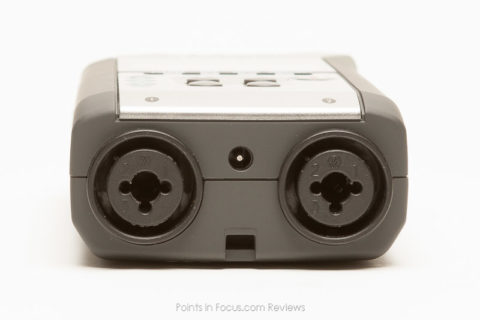
The H4n arrives at its 4 channels with 3 inputs, 2 mono combination XLR and 1/4” phone jacks, and a stereo 1/8” TRS jack that shares the channel with the built in stereo microphones. There’s a lot of flexibility in the inputs.
The unbalanced stereo input has an input impedance of 2k ohm, and the gain can be varied from -7 to -47 dBm. Additionally the stereo input can provide power for external microphones, thought Zoom doesn’t give the exact specifications, and I’m not entirely sure what they are.
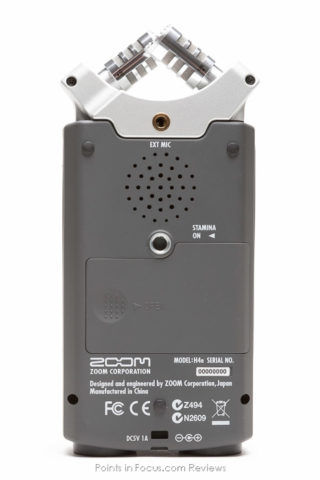
The combination XLR/phone-plugs inputs are characterized as follows. The XLR inputs are balanced mic-level inputs with an input impedance of 1K ohm, the input levels are between -10 to -42dBm. The 1/4” phone plugs are line level inputs with an input impedance of 480k ohm, and an input level between +2 and -32 dBm. Additionally, the XLR connectors are capable of providing phantom power at 24V and 48V.
Recording Modes
The H4n can record in either WAV or MP3 formats. WAV files conform to the broadcast wave format including time stamps and queue marks. WAV files can be recorded in 44.1KHz and 48KHz in all modes, and 96KHz in 2-channel mode only; and at either 16- or 24-bit bit-depths.
MP3s can be as CBR files with bitrates of 48, 56, 64, 80, 96, 112, 128, 160, 192, 224, 256, and 320 kbps. Additionally the H4n can produce VRB files; though there’s no way to set the minimum or target bitrates.
For the VDSLR shooter whose goal is improved audio quality, hence the external recorder, the MP3 modes are superfluous, and quite honestly I don’t see a strong reason to use the 44.1 KHz mode WAV mode since that’ll be lower quality than most of the higher tier VDSLRs record natively.
The vast majority of the time my H4n is recording, it’s recording 24-bit 48 KHz WAVs. While some might argue for using 96 KHz, the minuscule improvement in audio quality is simply not worth doubling my file sizes, and isn’t available in 4 channel mode, so I’ve never bothered with it.
Recording
When recording normally, the first time the rec button is pressed the H4n enters recording standby mode, where it displays the current audio levels and allows you to set the mic gains (though the gains can be adjusted at any time while the H4n is recording or in standby). Pressing the record button a second time, starts the H4n recording. If you’re recording a WAV file, pressing the record button while the H4n is recording places a mark in the file.
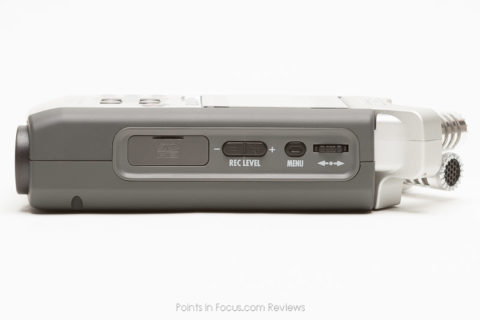
Pressing the stop button while the H4n is recording, in recording standby, or paused while recording returns the device to the normal standby state, saves the file, and increments the file counter.
There’s a level triggered recording mode, which I’ve actually found to be quite useful. I’ve used this when recording voice over scripts as it will trigger when I start talking and stop a specified number of seconds after I stop talking. For me this has the advantage of breaking takes into separate files automatically instead of me having to manually break one large file apart or having to keep hitting the record and stop buttons. One potential use of the level triggered record, though admittedly I haven’t tried it out in practice, is to use it to start the H4n when shooting synced sound with clap sticks or a clapperboard without having to press the record button manually.
Monitoring and Playback
The H4n provides a single line/phone out jack with adjustable volume levels. The line output is consumer line level (-10 dBm) as opposed to pro-line level (+4dBm).
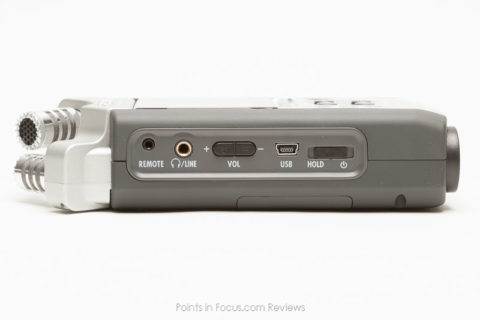
I’m not entirely sure how the H4n detects whether to run in headphone or line out mode, most likely by looking at the impedance on the line with anything less than say 1K ohm being headphones, and anything greater than that being line out. For example, if you’re looking to attach your H4n’s out to y our DSLR’s mic connection you’ll need an attenuator with sufficient impedance to trip things over. Plugging the H4n directly into my SLR didn’t work, regardless of what the output volume was set to. However, with the 10K ohm impedance in the attenuator I built for it, it works perfectly.
Additionally, the H4n has a built-in speaker for playback when the line/phones jack in unoccupied.
By default, the H4n only starts monitoring the input signals when the device is in record standby mode. However, there is an option in the Input menu to enable monitoring at all times (INPUT-> MONITOR->ON) which will always allow monitoring if there is a headphone plugged in regardless of whether the H4n is in record standby mode or not. Sadly, in this configuration doesn’t shortcut the record standby mode on the first press of the record button.
Power and Battery
The H4n can derive power from three sources, the AA batteries, a supplied AC adapter, and the USB bus.
Normally power would be provided by a pair of AA batteries. Either standard alkaline or Nickle Metal-Hydride (NiMH) chemistries can be used; and there is a configuration option to tell the H4n what batteries you’re using. Zoom suggests that you should see 6 hours of recording time in standard mode, and 11 hours in stamina mode, though actual times will vary based on sample rate and whether or not the H4n is supplying power to the attached microphones. I can’t vouch for the estimated run time; I haven’t done any recording for that long.
Secondary power input is provided via a standard DC power connector requiring 1 amp at 5V with the pin being positive (+) and the shield being negative (-). Zoom supplies a suitable power adapter with the H4n so there’s no need to spend more on a power adapter. When plugged in via the power adapter, the H4n has its full functionality available.
When powered via the USB bus the H4n can provide both 24V and 48V phantom power, as well as plug-in power for attached microphones, though can provide 2 channels at 16-bit and either 44.1KHz or 48KHz.
User Interface
If there’s one downside to the H4n, it’s the clunky user interface. It’s not headache inducing bad, but it could be so much cleaner and easier.
Controls are spread all over the unit, along with the inputs, and configurations for some key options aren’t accessible without digging though the menu system while other less critical options are made easily accessible as buttons. While I can see some of the utility when viewing the device with a musician-oriented eye, as a VDSLR the design choices can be frustrating at best.
Connectors
The connections are sprinkled around the recorder in a fashion that leaves me scratching my head a bit. The combination XLR/phone connectors are on the bottom edge of the unit, but the unbalanced stereo mic input in on the back, and the headphone/monitor out is on the left edge. If you’re using all 4 channels with external sources and monitoring with headphones, you’ll have cords connected to 3 different sides of the H4n.
I know this isn’t a super high-end field recorder, but that’s a bit crazy. If you’re intending to carry the H4n in a pouch, you’ll probably want to get some 1/8” TRS right-angle adapters (like this(Affiliate Link) ) or short right-angle cables, just to get the cables oriented in one direction without taking up much space.
In all honesty, the cable issues could have been subverted simply placing the inputs and outputs more intelligently. For example, the stereo mic input could have gone on the front edge by the built-in mics, since their use is mutually exclusive it wouldn’t be an issue either. Likewise, there’s enough room on the bottom of the unit to place the headphone/line out connect.
The other side effect of the layout of the H4n is that a case is virtually useless. The top, bottom, front, and both sides have to be almost completely cut out to allow access to the controls. More so, since Zoom didn’t locate all the typically used controls on one side of the device, a case maker can’t have side covers, as they’d usually be open to allow access.
Controls
I think some more thought could have gone into the location of controls on the H4n as well. Overall, they aren’t horrible, but they certainly could be better.
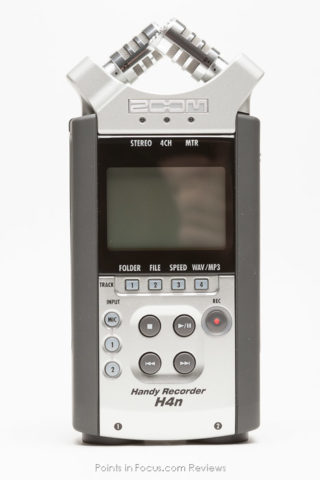
For example, prime real estate under the display has been given to 4 small buttons allowing direct access to select a file, select a folder, change the playback speed, and change the bit-depth and sample rate (among other things). Unfortunately, none of those functions are especially useful for the VDSLR shooter, and certainly not to the level that they need to be hardware buttons instead of menu items.
What I think would have been far more useful is to make those 4 buttons user customizable shortcuts that could be used to jump directly to a menu of the user’s choice. For example, while I might keep folder and file for playback reasons, the other two for me would be much more useful as phantom power and auto rec.
Issues
There are a couple of big issues with the H4n, though I’ve yet to experience any first hand.
Power & Data Integrity
The number one issue is that some users have reported losing their data when the batteries die. According to them, unlike many devices, the H4n doesn’t finalize the file and write the FS metadata until the recording is stopped. As a result, if power runs out while it’s recording, the file doesn’t show up on the SD card. That said, I’ve also read of a number of accounts of people recovering the data with file recovery software.
Data loss is an especially bad thing. Ideally, the H4n should safely power down, and save the current file, before the battery is completely exhausted. However, it’s also something that’s easy enough to address by just insuring you have fresh batteries in the H4n at the start of every session.
That said, I would also point out that the H4n requires you to manually select the type of battery you’re using it with (between alkaline and NiMH). I draw attention to this because the voltage of NiMH and alkaline batteries don’t behave the same when the batteries are being discharged. It may very well be that Zoom is properly handling the out of power situation, but only if the device knows what kind of battery it’s using. I also note this, because in the vast majority of cases I’ve read about data loss, there’s no mention of battery type or the battery-type set on the H4n.
I haven’t yet tested whether or not properly setting the battery type will cause or prevent data loss, or whether or not data loss at power down is in fact a reality yet. However, I would strongly suggest that you insure the battery type is correctly set on your H4n regardless, if only to have an accurate indicator of remaining charge.
Boot Speed
Another oddity I’ve run into with the H4n is that its initialization time seems to be affected by the size of the flash card. Specifically, my H4n boots from cold shutdown to the standby screen in about 10 second with a 2GB card. However, with a 32GB USH1 SDHC card, the boot is considerably longer (almost a minute). I’m not at all sure what Zoom is doing with the card on boot, but there’s no reason I can see that it should take any longer to boot with a blank 32GB card than a blank 2GB card.
Mic Levels
The H4n has some compatibility issues with certain microphones, most notably the Rode NTG2 shotgun mic. The exact reason for the issue I’m not entirely clear on; I’ve seen some people indicate that it’s due to the low 1K ohm input impedance on the XLR connectors, and others that it’s merely because there isn’t enough gain on the pre-amps. In any event, the result is that some microphones, notably ones with an impedance of 200ohms or more, may be very quiet.
I can testify to this, at least using my Rode VideoMic Pro (200 ohms). I see about a 12 dB lower signal from the video mic pro when using a VXLR and an XLR input than when plugged into the unbalanced stereo jack on the back of the H4n. At least on the video mic pro, I can easily compensate by switching on it’s built in +20 dB gain mode, but that’s not an option on most XLR mics.
Unfortunately, what I can’t speak to is how much of an issue this really is in practice. The Video Mic pro easily overcomes the problem thanks to the +20 dB mode, and I don’t have a low impedance XLR mic to test with otherwise. That said, while you can easily boost 12dB in post I’d rather not have to.
Honestly, I’d say this issue should lead to some careful consideration, either about the H4n or about your choices in mics. That said, the number of mics that are adversely affected is reportedly low; of all the Rode mics commonly used in video production, only the NTG2 is reported to have a low levels problem.
Compared to:
Tascam DR-100MkII
When I was researching the H4n the big secondary contender was the Tascam DR-100MkII. The DR-100 is markedly better in some ways, and not in others. On the positive side, the DR-100 has serious pro level inputs, and I’ve yet to read a report of it not working properly with mics. It also has selectable input gains prior to reaching the input volume level. That is a quiet mic can be run at high (-70dBu to -54dBu) while a hot mic can be run at low (-14dBU to +2dBu). The DR-100MkII also wears it’s controls on its sleeve so to speak.
On the other hand, I considered a number of factors against the DR-100MkII. The starting point was that it didn’t have convenient inputs for the equipment I have. There’s no mic-level 1/8” TRS connector for example. I’m not sure whether it’s a good idea to buy for what you have now, or what you might have in the future, but adapting my current non-XLR mics to XLR just to get them to work with the DR-100mkII didn’t seem ideal.
Secondly, it wasn’t a 4-track recorder. I probably weighted this more heavily than I should have, but I rather wanted the ability to mic two people separately and record a stereo ambient track instead of having to mix down to that or rely on the camera to get the ambient track.
I also wasn’t thrilled about the battery options. Okay options are good, but I wasn’t thrilled about a built in Lithium Ion battery that only got 25% more record time (5 hours instead of 4) than 2 NiMH batteries. On the other hand, the H4n should get an estimated 6 hours out of 2 AAs.
Tascam DR-60D
Of course, it always seems like after you buy something, someone comes out with what you really wanted, and the Tascam DR-60D seems like that’s it. It was introduced in NAB-2013, and is probably the best recorder for VDSLR shooters that I’ve seen yet. Though it’s $100 more expensive than the H4n and $150 more expensive than the DR-100mkII, if I was going to buy an audio recorder now, this would be the device.
The DR-60D hits all the right notes for me:
- 4-channel recorder
- 2- selectable line/mic level XLR/TRS combo jacks with:
- phantom power (24V and 48V)
- 3 base gain settings (+11dB, +36dB, +52dB)
- 2K ohm input impedances
- 1- 1/8” TRS Stereo jack with:
- Plug-in power
- 2 gains (+3dB, & +10dB)
- 10K ohm input impedance
- 1- 1/8” TRS Stereo Camera In
- to loop the camera headphone out though the recorder
- 1- 1/8” TRS Stereo Camera out
- mic-level with adjustable gain for looping sound back to the camera
- Dual level recording to prevent/recover from clipping
- Line out
- Headphones out
- 4 AA batteries + an optional 6AA battery pack
Recommendations
Unfortunately when I started looking for an audio recorder, the general summary of the situation I came to was that they all suck, but for different reasons. At the time, I considered the H4n to be the one that best fit what I needed at the time and what I planned to grow into in the near future.
Unfortunately, time marches on and it seems like I’m always on the short end of the stick buying something right before it’s replaced. 2 months ago the Tascam DR-100mkII was at least worth a look, even if I ended up deciding against it. However, the Tascam DR-60D that was released just before NAB 2013 has changed the situation dramatically. It’s not that the H4n is not compelling in many ways in its own right; it’s that the DR-60D is just so much better at hitting all the right notes. For example the mic-level camera out means you can do sync sound without having to build or buy a attenuator to connect the camera to the recorder.
While I won’t say, “avoid the H4n,” because there’s little reason to do so, I will say if you’re considering an H4n for DSLR video, look at the Tascam DR-60D first.
Comments
There are no comments on this article yet. Why don't you start the discussion?